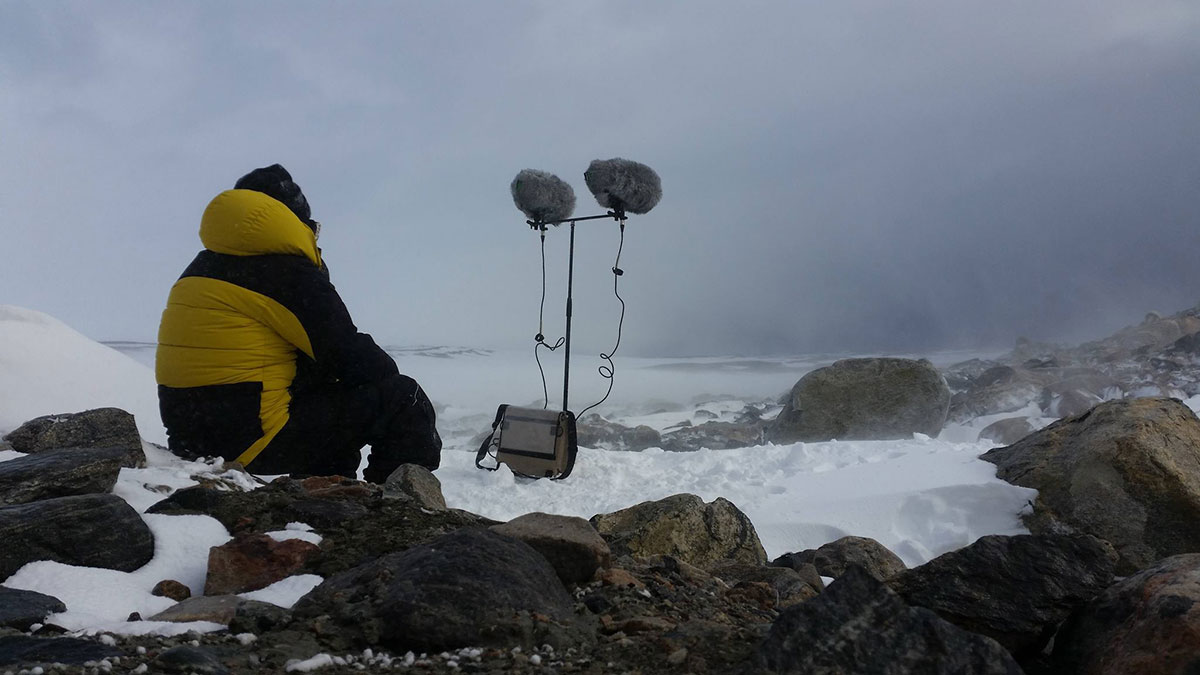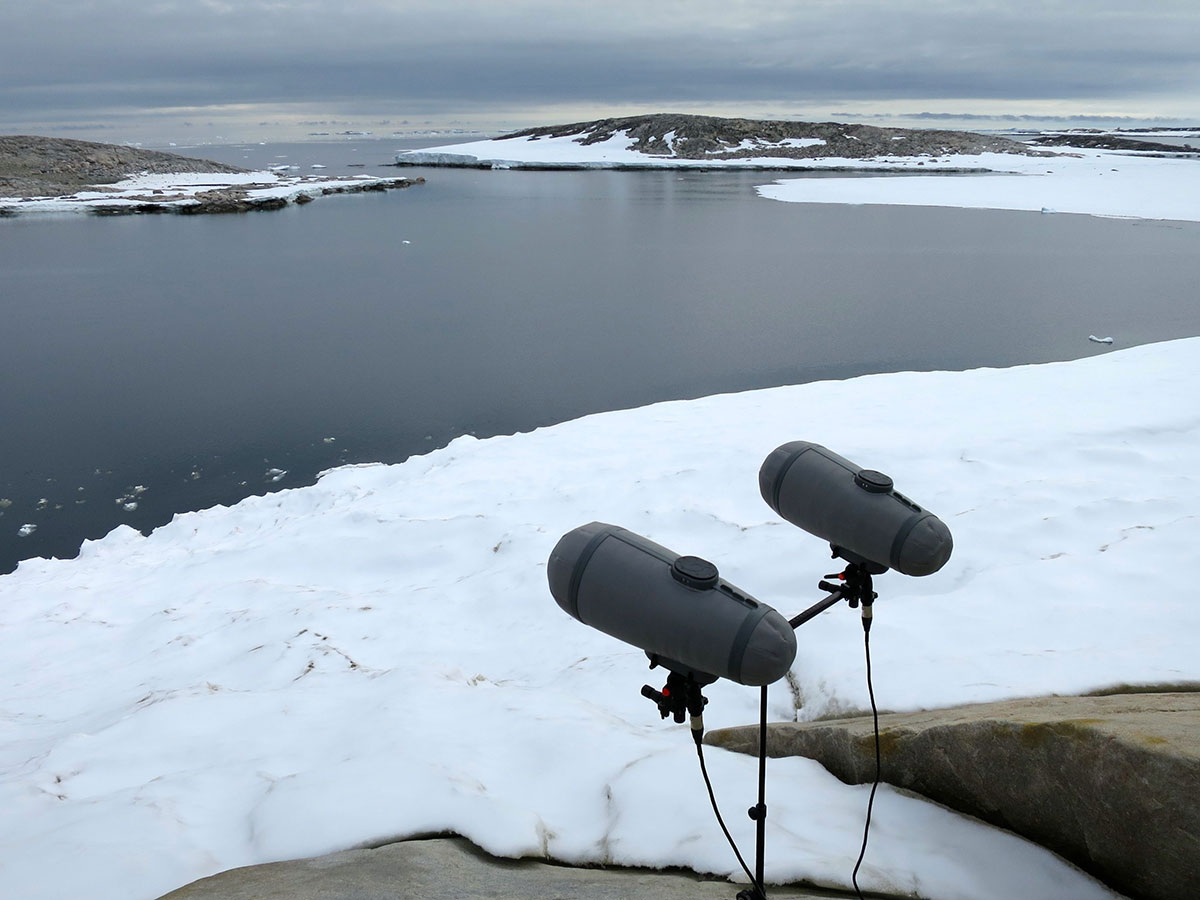
Antarctic Fellowship: Sounds from the home of The Blizzard
3800 kilometres south of Perth, overlooking the Windmill Islands is Casey Station, the biggest of three Australian Antarctic research stations situated in Eastern Antarctica. The sprawling site on a craggy outcrop accommodates up to 100 people during the busy summer season, which spans November to March. East is Law Dome, rising ever so gently towards a peak of 1400 metres, while in the west is Shirley Island and its boisterous population of Adélie penguins.
Directly across from Casey is Newcomb Bay where the abandoned US station Wilkes is located, and just beyond it a horizon filled with icebergs of assorted shapes and sizes. Wilkins Runway is approximately 70 kilometers south-east and serves as a desolate terminal for the intercontinental air service. It takes four and a half hours to reach Wilkins from Hobart and a further four hours to reach Casey by Hagglund. The terrain between Wilkins and Casey is flat with only rutted Caterpillar tracks and sparse waypoint markers disrupting the pristine vista of white striae set against the deep blue sky.
I am at Casey as the Australian Antarctic Division Arts Fellow. The fellowship is offered each year for an artist to undertake a project within the Australian Antarctic Territory. The current program has been running for three decades and has hosted artists from various backgrounds and disciplines. I’m here to document the presence and effects of katabatic wind on the station as well as the general environment.
Katabatic wind is a low gravity wind that gains force as it travels down elevated slopes. It is particularly prevalent at Casey due to the station’s location at the base of Law Dome where the wind oscillates between mild and strong. When the cooler temperature of a katabatic mixes with the warmer temperature of the onshore wind, a very unstable weather system emerges. No two days are ever alike which makes Casey a fascinating place when it comes to weather observation.

Philip Samartzis, sound recording, photo courtesy the artist
My project emerges from a fascination with the photography of Herbert Ponting and Frank Hurley who combined subject, composition and climate to convey the sense of a deeply mysterious and alien place. I am particularly intrigued by Hurley’s depictions of life on the ice in two iconic photographs, The Blizzard and Leaning on the Wind, both taken in 1912. The photographs convey the ferocity and atmospheric effects of the conditions using a mix of techniques including staged scenes and composite printing to viscerally express something that is close to impossible to articulate through conventional documentary photography. It is something Hurley was criticised for but which I deeply admire about his work. Inspired by these evocative depictions of abstract landscapes shaped by volatile conditions, I wondered how I could produce an equivalent account using sound recording techniques and technologies to render an embodied experience of extreme climate.
The time I have spent at Casey has acutely sharpened my sense of audition. The stillness enveloping the station and its environs provides an immaculate framework for close listening, in which each and every sound is uttered in intoxicating detail. The protean conditions inevitably shape the way these sound events propagate throughout the built and natural environment leading to complex aural and spatial cues and interactions. The main powerhouse is the constant sound emitter on station—its deep omnipresent thrum radiating all the way out to station limits and beyond. Within its radius assorted industrial sounds occur generated by heavy machinery used for construction, maintenance and transport. Staggered throughout the station are various buildings used as workshops and for storage, or for operations, science and meteorology that are sources of localised sound events. The circulation of these concentrated sounds within a pristine soundscape provides a heightened experience of industrial and mechanical noise that is simply breathtaking.
With snowfall the industrial exuberance becomes muted, as does the pervasiveness of the diesel engines resounding throughout the station. Eventually the snow becomes more audible, rhythmically triggering various metal surfaces with a gentle but persistent patter. As the wind exerts its influence the patter becomes strident with disused fuel drums, oxygen tanks, steel crates and landings filtering the sound into a syncopated series of resonant patterns. Depending on temperature and wind speed, snow can quickly transform into hardened granules of ice that generate showers of oscillating noise as they collide with various objects. The effect is particularly notable on large sheets of heavy plastic used to cover various building materials. The sound of people wearing heavily reinforced Baffin Boots moving around the station is also quite distinctly heard as they negotiate snow flurries, ice and rock-strewn paths.
The presence of katabatic wind inevitably shapes the way sound is heard and experienced on and off station. It can push sound away from you and it can draw it closer to you. Its intensity can mask sound and its absence can heighten it. At its most ferocious it simply obliterates everything within its path. A collision with the built environment transforms a katabatic into an intense series of ascending and descending pitches—a supercharged aeolian harp. Inside, station time and space are distilled into a series of discrete sonic gestures: a howling air vent, shuddering doorway, convulsing ceiling or a disconsolate-sounding hallway. Each event seemingly occurs in complete isolation as the station waits breathlessly for the blizzard to pass. While sheltering in an ice-encrusted porch I am informed that wind gusts are exceeding 185 kph. The piercing shrieks of the anemometer emerging from the white abyss are testimony to its ferocity.
Over three weeks I recorded an assortment of sound activated by wind and shaped by the cold—ice granules dancing across sheet metal, agitated flags, murmuring cables, brittle plastic sheets billowing in the wind, indifferent buildings and infrastructure, wind gusting across desolate ice fields, and the transformative effects of warming and cooling upon the polar environment. I have not experienced a place so mutable, so confounding. A century has passed since Hurley documented the dramatic events at Cape Denison. I wasn’t anticipating weather events of the type that he endured, nor was I seeking them. The effects of katabatic wind are intriguing for their subtle qualities as much as their capacity to express nature in extremis. Wind and cold are elements not easily rendered but I am hopeful I have captured in the sonic ecology of this rarefied place something that is new and evocative for those who have encountered the ice—whether in actuality or in dreams.
–
Listen to Philip Samartzis’ recordings from Casey Station in February this year.
For more cool arts adventures, at both poles, see Matthew Lorenzon’s coverage of Alice Giles’ project for harp, voice and electronics, Alice in the Antarctic and Urszula Dawkins on her experiences as part of The Arctic Circle international arts/science collaborative residency in Svalbard, Norway.
Philip Samartzis is the artistic director of the Bogong Centre for Sound Culture (see reviews of the Bogong Air Festival here and here) and sound coordinator in the School of Art, RMIT University, Melbourne. His book An Absent Presence, published by Thames & Hudson, will be available in May.






